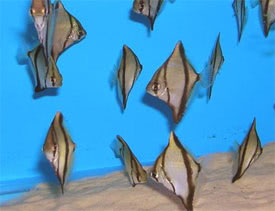
 Magyarul / Hungarian
Magyarul / Hungarian



- Scientific name: Monodactylus sebae
- Synonyms: Psettias sebae, Psettus sebae
- Common name: Seba Mono, African moony, African fingerfish
- Group: Brackish fishes
- Habitat: West Africa, Canary Islands and Senegal to Angola
- Size: 25 cm, but usually smaller in aquarium.
- Biotope: Inhabits mainly estuaries and mangroves, rarely enters lagoons and freshwater.
- Social behavior: An active, peaceful schooling fish, but they can be predatory towards smaller fish. Often the fish are timid and nervous in an aquarium. Semi-aggressive towards its own kind, and best kept in a group of 5-6 or more to spread the aggression.
- Diet: Omnivorous; will accept most live and frozen foods. In the wild, they eat large amounts of vegetable matter, so provide them lettuce and other vegetables.
- Breeding: Very rare in auqarium.
- Tank: Minimum 400 litres
- Population: 5-6 fish for 500 litres
- Decoration: Provide a bottom of coral sand or other calcium containing materials, such as dolomite. Smooth rocks, roots, or branches are ideal decoration. Large aquarium with plenty of open swimming space.
- Temperature: 24-28 °C
- pH: 7.2-8.4
- Hardness: 8-12 NK°
- Lifespan: 8-10 years
Description: Monodactylus sebae is diamond shaped fish with a larger anal fin than the Monodactylus argenteus. African moony has a silver body with two black lines on the head (one through the eye, and one behind the gill cover), and one thick dark band from the tip of the dorsal fin to the tip of the anal fin. Keep Monodactylus sebae only in salt or brackish water, since freshwater does not agree with the fish over long term. Gradual change from brackish to saltwater will maximize the coloration and the health of the fish as they become older. The difference between the sexes is unknown. There is only a few information available about their breeding habits, in nature the adults swim upstream to freshwater to spawn, then after the fry hatch, they float downstream to brackish water. This is very hard to mimic under aquarium conditions. Best method to keep them in marine water, and each day change a small amount of water to freshwater, so the salinity would decrease each day. After a few days the Seba Mono will spawn. The females release the eggs and the males presumably fertilize the newly released eggs. The eggs are very small, and the number of the eggs can be 10000. It is very hard to raise the fry. Adding some aquarium salt every few days to the water could emulate their natural habitat.




